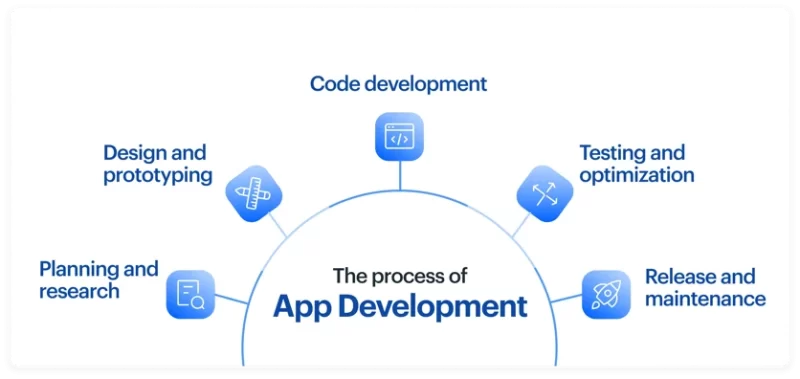Enterprises seeking to future-proof their operations, boost efficiency and cooperation, and enhance customer experiences now need to develop specialized business apps.
All CIOs are already aware, though, that the need for business apps is growing faster than IT can supply. The resources are pushed thin and app development techniques are out of date.
Knowing application development and how to include IT and business users utilizing an application development platform at scale is crucial to increasing application velocity.
Application development: definition
Planning, designing, developing, testing, and deploying a software application to carry out different commercial activities is known as application development, or app development. One independent developer or huge corporations with significant teams working on projects can achieve it. Application development outlines the creation process of an application and usually adheres to a set of guidelines.
Numerous elements influence the process of developing an application. The project’s size, degree of specificity in the requirements, degree of client desire for changes, size and experience of the development team, and project deadline all need to be taken into account.
What advantages provide application development?
An app developer can provide companies a competitive edge in their sector by helping them develop and fortify their brand. Applications development has the following advantages:
-
Greater involvement of the client: The software gives companies one more way to interact with their clients. Consumers may rapidly access goods and services, get updates, and offer comments thanks to it.
-
Improvements to branding: Applications give companies a stage on which to present their goods or services and communicate their goals and beliefs, therefore helping them to develop and strengthen their brand.
-
Really effective: Businesses can also enhance their internal operations by using composable applications, which let them to cut expenses, increase productivity, and streamline procedures.
-
Gathering and evaluating of data: Businesses can leverage the insightful data an app offers on user preferences and behavior to better customer experiences and marketing plans.
Which stages include an application development?
The process of developing an app is intricate and multi-staged; meticulous planning, designing, construction, testing, and launch are necessary. Working in concert, several teams and experts produce an app that satisfies user wants and expectations.
What constitute the primary phases of application development?

Software development life cycle and application development are related. Following are the fundamental phases and stages of the SDLC for app development.
- Organization and investigation
- Designs and prototypes
- Development of codes
- Optimal testing
- Publishing and upkeep
The goal of the app has to be made very evident to those involved throughout the planning phase. Among other things, developers look into hardware and software needs, marketers look into market demand and feasibility, and business teams look into growth prospects and competition.
Design and prototype
To fulfill the needs, developers define a design. Usually, draft sketches are made on paper first. The structure of the app may then be better visualized with wireframes, and possible issues can be found with a prototype.
Development of codes
Based on the iterations and early testing, developers now write the code the app needs to work as intended. Development at this point is of two types: server-side back-end development and user-side front-end development, which encompasses UX and UI.
Tests and optimization
Formal user testing of the app is conducted in order to confirm its features and usability as well as to find any user issues that were maybe missed during development.
The release and upkeep
Final production and release of the app are possible after testing. The staff must then keep an eye out for any bugs or other problems and act fast to fix them. Although they can be made after the app is out, changes and improvements need to be strictly tested and monitored in order to gauge their efficacy.
What distinctions exists between software and app development?
Software and app development are two different fields even if they have certain parallels. Development of software and apps differ primarily in the following ways:
-
First priority was design, user experience, and customizable features in the app development software development.
- Concentrated on following the correct codes and the quality requirements.
- The steps are strategy, design and branding, coding and development, launch, upkeep, and optimization.
- The procedure consists in coming up with specifications, creating, programming, recording, testing, and launching.
-
Generally, apps are simpler and made to carry out particular functions.
- The feature and capability range of software programs is wider.
- The release cycle of apps is often quicker, with more regular updates and new versions.
Because software development requires a lot of code and meeting of requirements, its release cycle is comparatively longer.
Which application development kinds exist?
The several categories of applications that are possible to create are,
-
Quick creation of applications
- More adaptable, rapid application development (RAD) emphasizes expediting the development process without sacrificing quality. With this method, developers may release changes more quickly, iterate many times, and get feedback without having to start from scratch each time. This contributes to producing a more quality-focused product that satisfies end-user needs as well. Keeping agility and speed first, RAD allows developers to complete projects in a few weeks or even days.
-
Developing bespoke applications
- Custom app development is an adapted process of creating and distributing software for certain users in order to satisfy corporate needs. Organizations trying to meet a specific need or goal choose this focused approach to app development. With this method, developers may build and deploy programs by exactly reproducing the idea conceived and provides features not available with an off-the-shelf solution.
-
Developing database applications
- Entry, central storage, and retrieval of information are the main goals of a database application development. When companies grow, managing data collected from several sources gets laborious and time-consuming.
-
Enterprise application development
- It is a cooperative process of creating specialized software to satisfy the intricate business requirements of big companies. This method facilitates the automation of particular features and procedures, therefore enabling users to do their work fast.
-
Developing web applications
- Web applications are websites with mobile app functionality. All users need to download is a web browser; no further software. Development of web applications is the least expensive and most straightforward of all the app types.
-
Development of citizen applications
- Software applications developed by non-professional developers, sometimes known as “citizen developers,” are known as citizen apps. While usually lacking in coding skills, many developers are eager to build their own apps.
How does app development pan out in the future?
Businesses are turning more and more to digital-first approaches, which calls for on-demand app development to support their efforts. The introduction of no-code and low-code has lessened the need for conventional software development and made it possible to create apps more quickly and affordably going forward.
Using visual interfaces and drag-and-drop components, low-code and no-code platforms let non-technical people build bespoke programs. Through their goal of expediting and simplifying the app development process, these platforms want to foster greater creativity and teamwork throughout the business.
Eighty percent of non-IT professionals will create apps by 2024, and more than sixty-five percent will do it with low-code/no-code technologies. This relieves overworked IT staff of manual, repetitious chores so they can concentrate on more difficult and important initiatives.
FAQs
How does app development work?
App development involves technical skills, creative design, and project management. App developers must be proficient in programming languages, mobile platforms, and application development tools and have a strong understanding of user experience design and app development best practices.
What does an application developer do?
An application developer is responsible for creating applications that run on various platforms. The specific tasks of an application developer can vary depending on the type of application they are developing, as well as the industry and company they work for
What are app development use cases?
The use cases for app development are diverse and constantly evolving as businesses continue to explore new ways to leverage technology to improve their operations. Here are some common examples- customer-facing apps, employee-facing apps, data management apps, educational apps, healthcare apps, etc.


